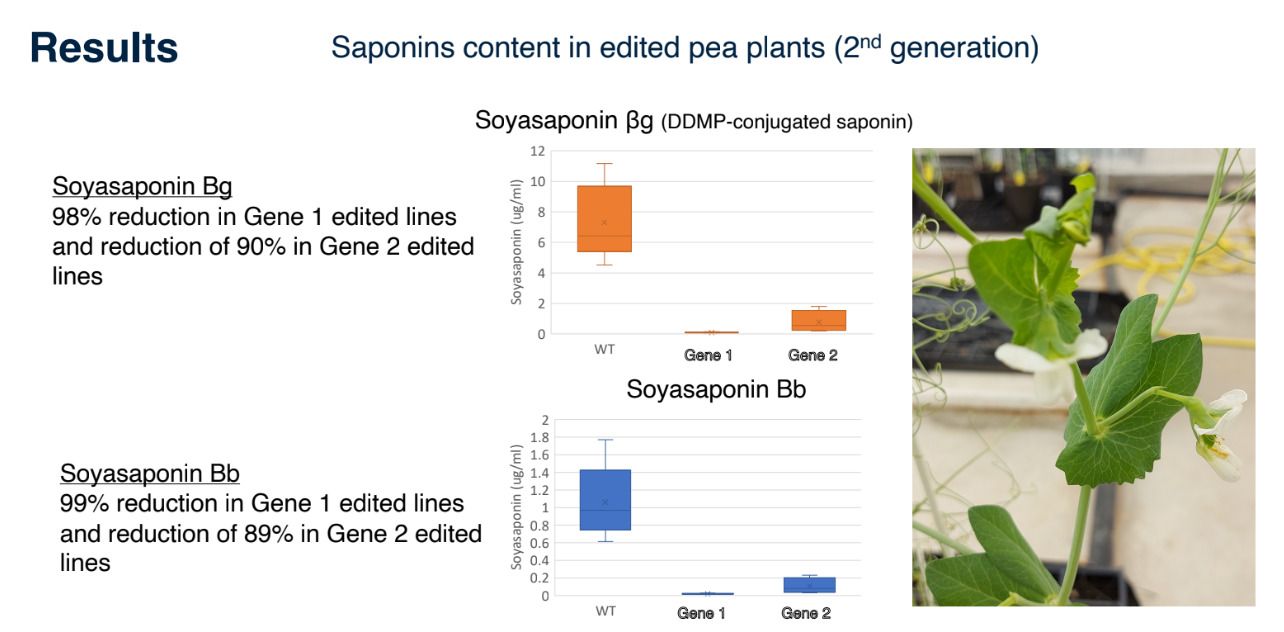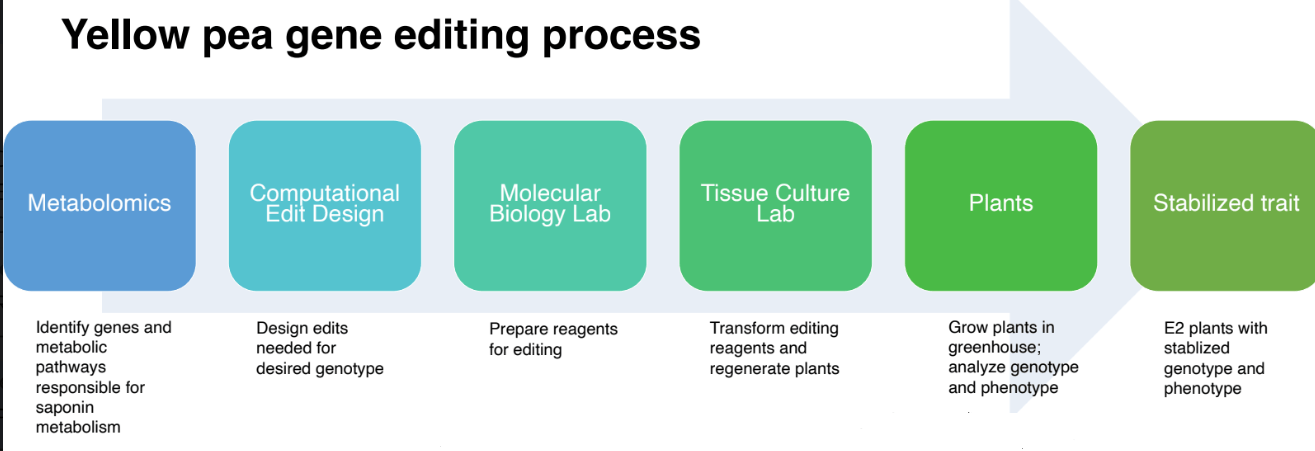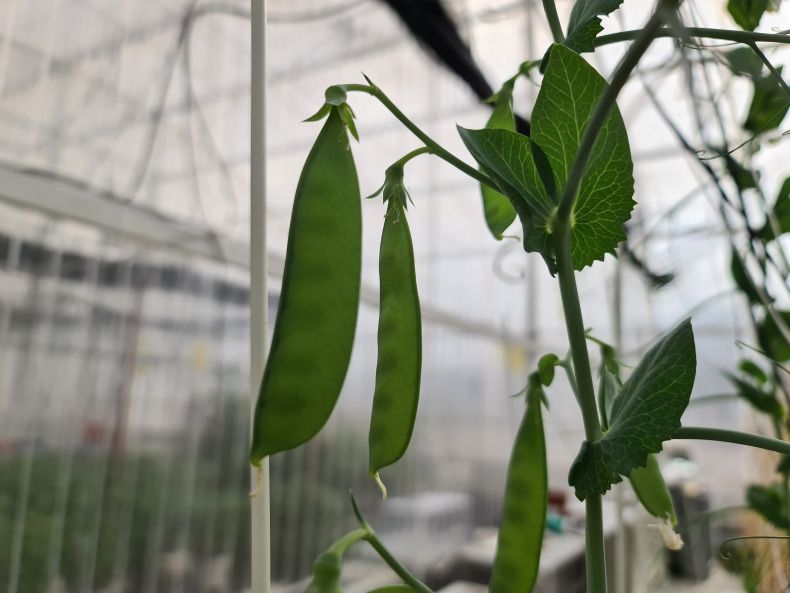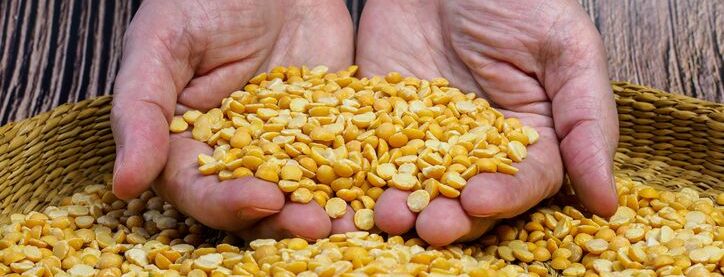- Israeli startup Plantae Bioscience says it has successfully deployed CRISPR gene editing techniques to slash levels of bitter-tasting saponins in yellow peas.
- The breakthrough “should lead to significantly improved taste in pea protein, as saponins are very bitter and difficult to remove via extraction,” claims the firm.
- The startup believes it is the first to use CRISPR to create an inherited trait in yellow peas.
- In most parts of the world, the peas would be considered Non GMO, claims the company.
Spun off from the Weizmann Institute of Science in Israel in 2021 with $6 million in seed funding from molecular biology innovation co Huminn, Plantae Bioscience uses a combination of computational protein-design, metabolomics and gene editing to create plants with new traits.
The startup, which now has a team of 12, is working on several innovations, from gene-edited fruits and vegetables with higher levels of phytonutrients to plant varieties designed for vertical farming that are “smaller, faster growing, low-light adjusted and flowering/fruiting synchronized.”
Its first project utilizes CRISPR techniques to reduce the levels of bitter-tasting saponins in yellow peas by up to 99%, SVP business development David Hart told AFN.
This is potentially an important breakthrough in the world of plant proteins, which often come with flavor issues, he claimed, although plant protein experts AFN spoke to noted that there are other sources of off-notes in legumes beyond saponins, notably the ‘beany’ or ‘grassy’ notes generated by fatty acid oxidation.
“Even at very, very, small dosages, saponins are perceived as bitter,” said Hart, “so when we tell people what we’re doing, they immediately get it.”
The challenge, he said, is that it’s hard to remove saponins during downstream processing, because they have a hydrophobic (water-hating) head and a hydrophilic (water-loving) tail. “If you use water to wash them away, you’ve still got an issue with the hydrophobic side, and if you use an oil-based solvent, you’ve got an issue with the hydrophilic side.
“So usually plant protein processors kind of kick the can down the road to customers to fix in the product formulation” through adding salt or adding expensive masking ingredients, he said.
We are basically using CRISPR to shut off the biosynthetic pathway of two major classes of saponins
Plantae, by contrast, is tackling the problem at source, said chief science officer Dr. Eyal Emmanuel.
“We are basically using CRISPR gene editing to shut off the biosynthetic pathway [that triggers the production] of two major classes of saponins responsible for the bitter taste in yellow pea protein.”
The IP underpinning the innovation is licensed to Plantae from the Weizmann Institute, said Hart, who claimed that Plantae is the first company to use CRISPR to create an inherited trait in yellow peas.
“What often happens is that people make gene edits and the traits are in the first generation, but they didn’t necessarily propagate those plants to the next generation. Our traits are inherited [and transfer to the second generation].”
‘In most markets we’re considered Non GMO’
The next step is propagating more seeds in order to move to field trials, said Hart.
Asked whether the edits to the genome have any other impact on the plants aside from preventing the accumulation of saponins, Dr. Emmanuel said: “We’re not seeing any other effects, but that’s another reason we need to upscale the seeds and perform field trials.”
According to Hart: “The same technology can be relevant for bitterness in other crops as well.”
As for the regulatory pathway in key markets such as North America, a major growing region for yellow peas, the fact Plantae is using gene editing rather than traditional transgenic techniques makes life easier, he said.
“In most markets we’re considered Non GMO, as we’re not introducing any foreign DNA. In the US, you need to apply to USDA for an exemption letter [showing that your innovation is exempt from the Plant Protection Act, which regulates biotech crops], but we don’t see major regulatory hurdles.”

The go-to-market strategy
When it comes to the go-to-market strategy, Plantae has had some initial conversations with key players in the pea protein space, said Hart.
“We’re looking to collaborate and have some sort of partnership with a significant player. It could be a company that’s developing new pea varieties, or probably more interesting would be a company dealing with pea protein.
“That collaboration could have any number of any number of directions from a simple out licensing deal, to a joint venture.”
So how quickly could this innovation get to market?
“Even once you have the traits you want to scale up, you have to have enough peas for thousands of acres, and that process alone takes a number of years,” said Hart. “So obviously having the right partner can speed that up.”

Tomatoes and lettuce with higher levels of phytosterols
When it comes to investors, said Hart—who is looking to raise additional money to advance other innovations Plantae is working on—having a suite of innovations with short, medium, and longer-term timelines is key.
“We’ve shown we can double or even triple levels of beta-sitosterol [a phytosterol found in some plants that reduces LDL cholesterol] in tomatoes and lettuce, for example.
“We have a layered approach, so certain things will have a faster time to revenue, and certain things have a longer time to revenue, but could present a more significant opportunity. So for instance, a lot of the work that we’re doing with plant varieties optimized for vertical farming is going to take a little bit longer, but we feel has a lot of potential.”
Doing more with less
Meanwhile, the unique structure of Plantae enables it to do more with less, said Dr. Emmauel. “When you consider our access to all of these leaders in their academic fields, you get a much larger team, so we’re not working on everything by ourselves.”
He explained: “Plantae was formed from a combination of Huminn and Yeda, the licensing or commercializing company of the Weitzman Institute to move technology from academia into a company. But we have an ongoing relationship and a master agreement that enables the company to get more innovation from those guys as we go.
“So in particular we have an ongoing relationship with three professors at Weizmann Institute that are globally recognized experts in their fields: Professor Sarel-Jacob Fleishman (computational protein and enzyme design); Professor Asaph Aharoni (metabolic engineering); and Professor Avraham Levy (genetics and gene editing).”





